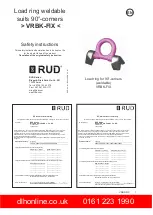
3
VRBK-FIX
HINTS
• Never weld at the quenched and tem-
pered ring!
• Weld all seams at the same temperature.
1. Check before initial appending of the VRBK-FIX,
the position of the weld-on blocks to each other,
that means the base area must be at the same
level.
2. Append weld-on blocks.
3. Check function of the ring.
The ring must be able to pivot 270°. If necessary
please correct.
4. Once appending and checking of the function
have been carried please finish the root run. The
outside positioned weld layers must be carried out
first. The described welding sequences must be
observed compulsive.
5. Begin at starting point S1 and weld subsequently
the sections 1-4 (Picture 1).
6. Then weld the opposite side identically (starting
point S2 and chapter 5-8).
7. Afterwards close the rot pass at the inside areas.
(chapter 9-10 and 11-12)
Pic. 1: Welding sequence of the root run (S=Starting point
8. Finally please let the parts cool down.
9 Remove any welding mistakes and dirt at the root
weld before applying the cover weld seams.
10.Subsequently please weld the closure welds.
Start at the inside. The described welding se-
quences must be observed compulsive. Chose
type and dimension of weld seam from picture 3
and chart 4.
11.Begin at starting point S3 and weld subsequently
the chapters 1-6 (picture 2)
12.Please weld then the opposite side identically.
(tarting point S4 and chapter 7-12)
HINT
Please adhere the requested weld seam
thickness in any cases. Any change can
result in a malfulction of the ring latch.
Pic. 2: Sequence of closure welding (S=Starting point)
13.Please check by a competent person after
welding the ongoing usage of the weld-on lifting
point (see chapter 4, Inspection criteria).
HINT:
By the position of the weld-seam (HY-weld
circumferential) the following requirements
will be observed: DIN 18800 steel construc-
tions requires: at outdoor buildings or when
strong corrosion must be expected weld
seams must be carried out as continuous
fillet weld seams.
Pic. 3: weld seam
+
+
S1
1
2
3
4
S2
11
12
9
8
7
6
5
10
S4
11
10
9
8
S3
7
12
1
2
3
4
5
6
3.4 User instruction
• Check frequently and before each initial operation
the whole lashing point in regard of linger ability as
a lifting mean, regarding corrosion, wear, deforma-
tion etc. (see chapter 4, Inspection criteria).
ATTENTION
Wrong positioned or damaged weld-on
lifting points as well as improper use can
lead to injuries of persons and damage at
property, when load falls down.
Please check all lifting points carefully
before every usage.
























